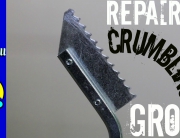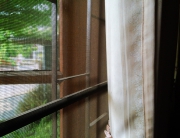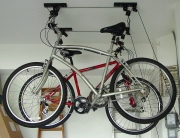
Turn an Inexpensive Door Into a Floating Shelf…Or Two! A floating shelf is a lovely addition to your home decor. Usually no wider than 8 – 10 inches, but up to a few feet in length, a floating shelf is a marvelous way to display pictures, knickknacks or artwork. It’s a great way to show off anything that you treasure or collect, the personal touches that really make a house a home.
All you need to build that floating shelf is a simple, inexpensive door from any home improvement store. In the simplest of terms, you make the floating shelf by cutting the door to the desired shelf size. This creates a “box” that you then slide onto a cleat that you have already attached to the wall. Secure the shelf/box to the cleat, and voila! You have just made a floating shelf. It is simple enough to put together in an afternoon, and will cost you maybe $30 for materials. Plus, you can save the other side of the door to make a second floating shelf at a later date.
No one has to know your secret (that you used a door instead of building the “box”), and you will appear to be a DIY genius to all who visit your home! Think of the pride you will feel when guests come in and admire your space, and you can say “I made that shelf myself!”.
Watch the following video and read the instructions below to learn how to make a floating shelf for your home.
-By See Jane Drill, Copyright 2014, All Rights Reserved
“Like” Us and Subscribe to Our Email List!
Written Instructions for Building a Floating Shelf
Time needed to complete project: 2 – 3 hours (not necessarily all at once)
Materials Cost: Approximately $30 for the door, lumber, and screws and fasteners.
Tools and Materials Needed
- 1 wood hollow-core door, unfinished
- 1 piece of wood to use as the cleat to anchor the shelf in place. It should be at least 2 inches in width. Later, you will measure the cavity of the door to determine the height and length of the cleat. It should fit snugly into the hollow of the door.
- Safety Glasses
- Lag screws or structural screws
- Wood glue
- Pencil
- Fastener of choice to attach the shelf to the cleat. Choose one of the following: cabinet screws, trim screws, wire brads (or an additional option is a pneumatic nailer)
- Table Saw
- Power Drill with assorted bits
- Cordless Screwdriver (optional)
- Measuring Tape
- Utility Knife
- Safety blade (a wood chisel is best)
- Level
- Stud Finder
- 1 Clamp
Step-by-Step Instructions
- Determine the width of the shelf that you want to build. (Between 8 and 10 inches is ideal for this project).
- Using the table saw, cut the door lengthwise to the chosen width.
- Using a utility knife, detach the cardboard from the inside walls of the door, down about 2 inches into the hollow of the door. Make sure that you scrape off any residue from the inside walls of the door as well, preferably with a safety blade or chisel.
- Measure the cavity of the door from inside wall to inside wall, so that you can cut the cleat to size. Make sure that the height is exactly the same (or up to 1/16th of an inch larger) than the height of the cavity, as it needs to fit snugly, and the “skin” of the door is slightly flexible.
- Cut the cleat to size
- Dry-fit the cleat into the cavity of the shelf. Don’t push it all the way in, as you don’t want it to get stuck. Just ensure that it will fit later on.
- Determine where on the wall you want the shelf to be placed, and mark it appropriately.
- Using the stud finder, locate the studs and mark stud center with a pencil for each stud.
- Hold up the cleat to the wall and also mark stud locations on the cleat with a pencil. Those marks will be where you will be attaching the cleat to the wall later on, and you will need to drill pilot holes before doing so.
- Drill pilot holes in the cleat with a drill equipped with a drill bit that is just slightly smaller in diameter than the diameter of the screws you will be using to attach the cleat to the wall.
- Before attaching the cleat to the wall, use a level to make certain the cleat is level. Attach the cleat to the wall with structural screws or lag screws, making sure to line up the pilot holes with stud center.
- Apply wood glue generously to the inside of the shelf and to the upper lip of the cleat if necessary.
- Slide the shelf into place over the cleat on the wall. Make sure it is snug. If you need to, carefully tap it with a hammer, using a piece of scrap wood as a buffer between the hammer and the shelf.
- Attach the shelf to the cleat with the fasteners that you have selected (see materials list). Space them approximately 1 foot apart. Make sure to attach the shelf both on the top and on the bottom.
- That is it! Feel free to stain the shelf or paint it if you like, or leave the wood natural.
And that’s all it takes to make a floating shelf! You did it!







Great idea, great job! Thanks!
You’re welcome, Peter, and thanks for posting! 🙂
how much weight would you say would be safe for this floating shelf
Hi Tee – It varies, however, as a general rule, those floating shelves are designed strictly for light-weight decorative items.
Hi, looks great! But how do you take it down, if the shelf is glued to the cleat?
Best video of this kind that I have seen..IShe covers everything you need to know and assumes nothing. Great teacher!
I watch your videos all the time. As a homeowner I have found so many helpful videos and tips. Thank you. The shelf looks great.